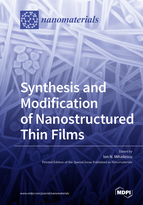Synthesis and Modification of Nanostructured Thin Films
A special issue of Nanomaterials (ISSN 2079-4991).
Deadline for manuscript submissions: closed (25 April 2019) | Viewed by 75081
Special Issue Editor
Interests: pulsed laser deposition; modification and characterization of nanostructured thin coatings; matrix-assisted pulsed laser evaporation (MAPLE); laser surface studies and processing; biomaterials thin layers; tissue engineering; biomimetic metallic implants; optoelectronics and sensors
Special Issues, Collections and Topics in MDPI journals
Special Issue Information
Dear Colleagues,
We invite you to contribute to a Special Issue of Nanomaterials entitled "Synthesis and Modification of Nanostructured Thin Films", which is devoted to nanostructures for applications in science, technology, and biomedicine. We expect new original results and interpretations in the synthesis of nanostructures with a special emphasis on complex characterizations and multifunctional utilizations.
This Special Issue is open to any kind of synthesis process and also includes multiple congruent characterization, complex interpretations of results, and recent applications in multiple fields.
The conviction of the Guest Editor is that many advances should be marked in the field and they deserve an up-to-date review. The authors should refer to previous progress in the field and try to focus on the latest developments within this domain.
We believe that the time has come for such an evaluation. The topics of this issue are quite generous starting from synthesis via characterization and going to last hour applications of nanomaterials.
Prof. Dr. Ion N. Mihailescu
Guest Editor
Manuscript Submission Information
Manuscripts should be submitted online at www.mdpi.com by registering and logging in to this website. Once you are registered, click here to go to the submission form. Manuscripts can be submitted until the deadline. All submissions that pass pre-check are peer-reviewed. Accepted papers will be published continuously in the journal (as soon as accepted) and will be listed together on the special issue website. Research articles, review articles as well as short communications are invited. For planned papers, a title and short abstract (about 100 words) can be sent to the Editorial Office for announcement on this website.
Submitted manuscripts should not have been published previously, nor be under consideration for publication elsewhere (except conference proceedings papers). All manuscripts are thoroughly refereed through a single-blind peer-review process. A guide for authors and other relevant information for submission of manuscripts is available on the Instructions for Authors page. Nanomaterials is an international peer-reviewed open access semimonthly journal published by MDPI.
Please visit the Instructions for Authors page before submitting a manuscript. The Article Processing Charge (APC) for publication in this open access journal is 2900 CHF (Swiss Francs). Submitted papers should be well formatted and use good English. Authors may use MDPI's English editing service prior to publication or during author revisions.
Keywords
- Synthesis of nanostructures
- Methods of synthesis
- Characterization of thin films and nanoparticles
- Key technological applications







